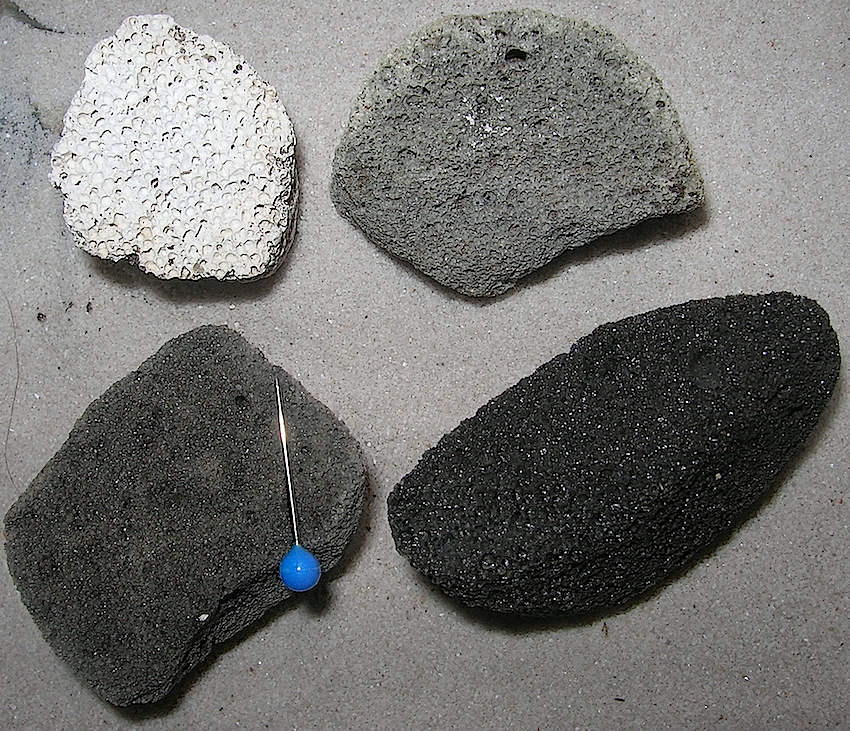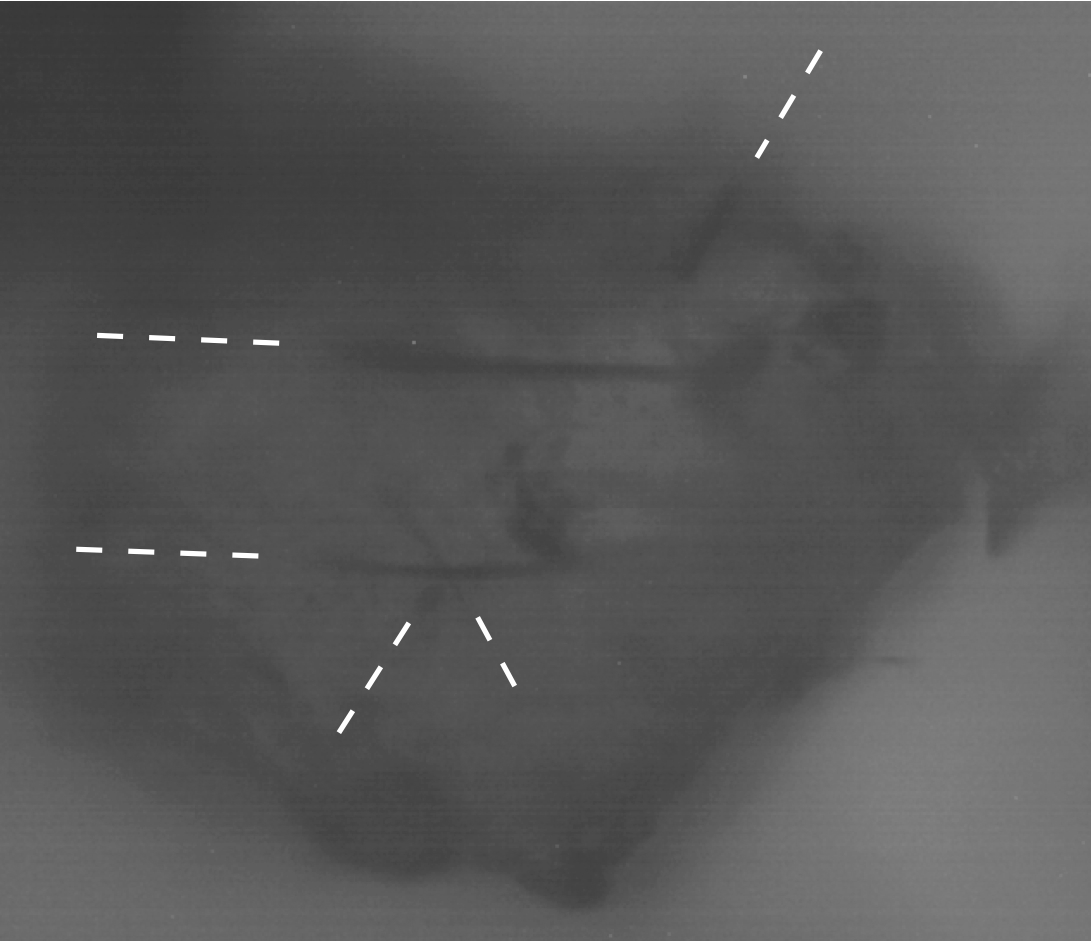Pumice is a porous volcanic rock that is formed in gas-rich explosive eruptions on mixing of lava and water. When pressure releases, the melt froths by expansion of carbon dioxide and water vapor, and on rapid cooling the peculiar strongly vesicular texture forms. Pumice is nearly exclusively composed of glass with few mineral inclusions and has up to 90 % porosity which is why in general it floats in water. Depending on the source material and the texture pumice occurs in a broad color spectrum, from nearly white to yellow, gray and practically black. Well known is the Italian pumice from Lipari and Stromboli, and in Germany pumice from the Eifel volcanism is exploited.
Pumice from Lake Chiemsee
Since a few years the intensified geological investigations of the crater strewn field of the Chiemgau meteorite impact has revealed abundant finds of pumice cobbles in the shore region of Lake Chiemsee.
Fig. 1. Pumice varieties from Lake Chiemsee. White pumice – gray, marginally whitish pumice – gray pumice – grayish-black pumice (from top left to lower right). Samples by courtesy of Ernst Neugebauer.
The pumice occurs in various color varieties (Fig. 1) the white pumice rather being rare. Under the microscope the texture of the white form differs from the gray and grayish-black varieties (Figs. 2, 3).
Fig. 2. Differing texture of the white and grayish/blackish varieties.
Fig. 3. White and grayish/blackish pumice varieties from Fig. 2 in close-up.
The difference becomes especially evident on larger magnification (Fig. 3) which shows distinctly broader partitions between the bubbles for the white pumice, for their part also exhibiting vesicular texture.
The difference is also a matter of material: An acid test of the white pumice shows a high carbonate amount which is very low in the grayish-black pumice. This corresponds with differing consistency. While the white pumice can easily be crumbled with one’s fingers the grayish-black pumice reacts with finest pulverization. In both cases the compressive strength is low as shown by simple indenting with the fingernail.
Grains under the microscope
Fig. 4. Grinded pumice on grain slide under the polarization microscope. Left: grayish-black pumice (plane polarized light). – Right: white pumice (crossed polarizers). In the lower middle of the image a quartz grain can be observed that exhibits planar fractures (PFs). The images are c. 500 µm wide.
Grain slides under the microscope are underlining the difference. The ground material of the grayish-black pumice (Fig. 4, upper) shows finely fractured shards of glass (extinction under crossed polarizers). Few mineral grains (quartz, white mica) and minute carbonate aggregates are interspersed. The glass itself shows vesicular texture and opaque lining of the voids.
The grains of the white pumice (Fig. 4, lower) consist of aggregates of finest crystallites which according to the acid treating should be carbonate (calcite). Compared with the glass in Fig. 4, upper, considerably more quartz grains, mostly sharp-edged fractured and sized of the order of 20 µm, are interspersed.
Fig. 5. Quartz grain exhibiting planar fractures (PFs) along three different orientations. The image is c. 30 µm wide.
Within the quartz grains the occurrence of planar fractures (cleavage) (Figs. 4, 5) is a prominent attribute. In the white pumice a large part of the numerous quartz grains show these fractures.
Origin
Volcanism?
Although pumice is a typical volcanic rock, an on-site volcanic formation can basically be excluded. An “import” of the pumice from known volcanic areas is in principle imaginable (for example in connection with Roman settlement). Because of the predominantly carbonate white pumice this explanation presents a nearly insoluble problem. Moreover, it doesn’t make much sense if pumice “imported” from some dark side and for unknown purposes was thrown into Lake Chiemsee in larger quantities to strand, nicely rounded, some decades later on the shore.
Anthropogenic, technical product?
Artificial products that are adapted from pumice are known in manifold variants. This includes, e.g., cellular glass, expanded glass, expanded clay, and foamed or porous concrete. As for the internal structure these materials are similar to the pumice as described. For a possible confusion, expanded glass and expanded clay are out of the question because they are produced in small granulation and in nodular form, respectively. Porous concrete consists mainly of a crystalline phase and not of glass and, moreover, is free of carbonate. In addition, all these technical products share a high compressive strength and acid resistance, and exactly these properties are lacking in the case of the Lake Chiemsee pumice. And like with the hypothetical volcanic origin these technically produced materials must ages ago have been thrown into Lake Chiemsee in considerable quantities so that they are today can be sampled as well-rounded cobbles.
The Lake Chiemsee pumice as an impact rock (impactite)
Like with the explosive volcanism, the meteorite impact process offers virtually ideal conditions for the production of pumice if certain requirements are fulfilled. For a better understanding it is once more pointed to the basic importance of shock wave propagation in an impact event. Behind the shock wave front of extreme pressure, extreme temperatures emerge on pressure release which, following the zone of vaporization, lead to melting of the impacted underground (see, e.g. here: http://www.impact-structures.com/understanding-the-impact-cratering-process-a-simple-approach/).
If the rocks in the ground are containing much water a mixing of the impact “magma” with the shocked water may occur, and on shock pressure release the same happens exactly like with the explosive volcanism: frothing of the rock melt and, on rapid cooling, the formation of a highly porous glass, the impact pumice. If in addition carbonate rocks (e.g., limestone) are contributing the shock-produced carbon dioxide may boost the process, and different from normal volcanism carbonate melt may be formed.
Exactly these conditions appear to have perfectly been fulfilled in the case of the Chiemgau impact. From the detailed SONAR echosounder measurements individual projectiles of the large impactor have evidently crashed into Lake Chiemsee as is documented by the rimmed doublet crater at the bottom of the lake. And there the already mentioned ideal conditions were met: a water-saturated sediment composed of glacial deposits, lake calcareous mud and clay.
Melting und explosive degassing of the silicate clay led to the formation of the grayish-black pumice, and carbonate rocks and lake calcareous mud were the source material for a carbonate melt being converted to the white, predominantly carbonate pumice.
This interpretation is supported by the occurrence of the already mentioned abundant quartz grains in the pumice matter exhibiting planar fractures (PFs, Figs. 4, 5). Although not proving in the strict sense PFs are strong evidence for a shock damage.
More detailed investigations of this peculiar pumice material will follow.
Affinities of pumice and the Chiemgau impact melt rocks (“swimstones”) as well as similar formations (volcanic and impact scoria) will also be discussed soon.
A foamy pumice texture in glasses from the Bosumtwi impact structure in Ghana has been reported by Boamah, D. & Koeberl, C. (2006): Petrographic studies of “fallout” suevite from outside the Bosumtwi impact structure, Ghana. – Meteoritics & Planetary Science 41, Nr 11, 1761–1774.







































